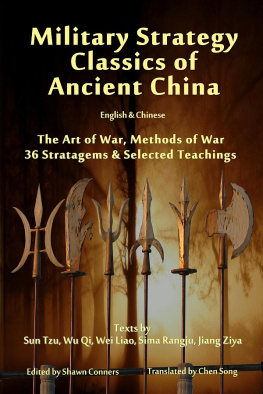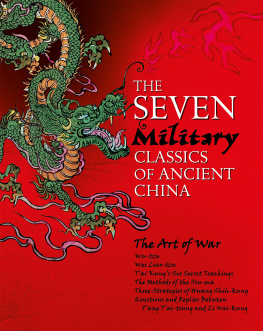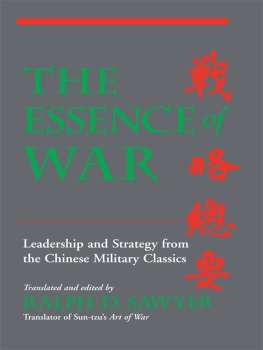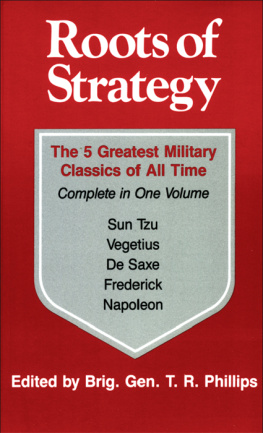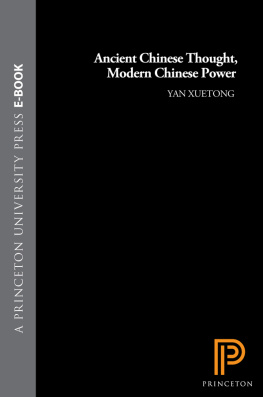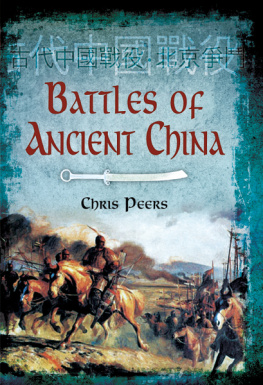
Military Strategy Classics
of
Ancient China
English & Chinese
The Art of War, Methods of War
36 Stratagems & Selected Teachings
Texts by
Sun Tzu, Wu Qi, Wei Liao, Sima Rangju, & Jiang Ziya
Edited by
Shawn Conners
Translated by
Chen Song

Introduction
Wearing the attire of a Confucian scholar, Wu Qi attended an audience with Lord Wen of Wei to discuss military matter s. Lord Wen of Wei announced, I do not have much interest in military matters.
Wu Qi replied, From plain visible facts, I can deduce the hidden. From the past, I can foretell the future. How can your Lordship sincerely say that he has no interest in this subject?
Interest in military superiority has existed among warriors, commanders, scholars and students, since the dawn of civilization. In the West, the ancient classic stories of Beowulf, Homer and Julius Caesar are, even centuries later, required reading in high schools and universities. This familiarity with the military achievements of the greatest warriors in our collective history is not limited to military scholars. Students taking Latin are required to read the military strategies of Julius Caesar: Gallia est omnis divisa in partes tres . Students of civics and law classes will learn from Machiavelli that the ends justify the means . Students of history will read the military exploits of Philip of Macedon, his son Alexander; Napoleon Bonaparte and his aide, Baron de Jomini; as well as Generals Lee and Grant from the American Civil War. Successful leaders in both Eastern and Western civilization have been, as Wu Qi rightly guessed, very much interested in military strategy.
. The area is home to the longest continuing civilization known to scholars. It is written that in the 29 th century BCE, the first Great Sovereign of China, Fu Xi () was born. According to legend, the land was swept by a great flood and only Fu Xi and his sister Nwa survived. They then retired to the mythological Kunlun Mountain to pray for Heavenly guidance. Fu Xi and Nwa used clay to create human figures, and with the divine power entrusted to them, made the clay figures come alive. Fu Xi then came to rule over his descendants for more than 100 years. Fu Xi taught his subjects to cook, to fish with nets, and to hunt with weapons made of iron.
The ancient Chinese were involved in frequent wars of unification, expansion and defense of their territories. They developed warfare on a sophisticated level to meet these demands. China produced massive infantry-based armies and navies which battled for control of the rivers of China.
As the implements of war were analyzed and improved upon, infantrymen employed a variety of more efficient weapons made of iron. Dagger-axes came in various lengths from nine to eighteen feet, and were used as thrusting spears with a slashing blade. A typical heavy infantryman may have been equipped with armor consisting of a leather jerkin covered with narrow bronze plates and a hardened leather helmet. His main weaponry would be a pole-arm with an iron head and a bronze dagger-axe for a secondary weapon. Heavy infantry would have been formed into large, close formations for battles.
The Qin later began producing stronger iron swords, crossbows and the compound bow. Another Chinese innovation allowed a crossbow to be rendered useless simply by removing two pins, preventing enemies from capturing a working model. The stirrup was also adopted at this time. Stirrups gave cavalry men greater balance and crucially allowed them to leverage the weight of the horse in a charge, without being unseated.
Qin army formations and tactics can be understood somewhat from the Terracotta Army of Qin Shi Huang found in the tomb of the First Emperor. There were over 8,000 soldiers, 130 chariots with 520 horses and 150 cavalry horses, the majority of which are still buried in the pits near Qin Shi Huang's mausoleum. The formations revealed that light infantry were first deployed as shock troops and skirmishers. They were followed by the main body of the army, consisting of heavy infantry. Cavalry and chariots were positioned behind the heavy infantry, used for flanking or charging. In order to counter the threat from the nomadic invaders of the time, the Qin began construction of the Great Wall, the building of which would last for centuries. The walls and fortifications would ultimately be 5,500 miles long, when counting all of its branches.

Later, more significant Chinese military inventions and improvements would follow. In the 9 th century of the Common Era, the Chinese were the first to develop gunpowder, followed in the 10 th century by the invention of the first gunpowder firearms. The first guns were spear-like weapons made of bamboo, called fire lances (). These short-ranged, one-shot, disposable weapons were often held in racks on city walls and gave Chinese defenders a tremendous tactical and psychological advantage when fired in volleys. They were ideal for dealing with enemies trying to scale city walls, or for holding the enemy at bay behind a breached gate. They were in widespread use by the time of the Song Dynasty in the 12 th century.
As was the case in Western counterpart, the Roman Empire, successive leaders extended Chinas boundaries primarily by military conquest. However, by the time of the Han Dynasty and the opening of the Silk Road trade routes, the teachings of Confucius had become the accepted canon of moral and political thought in China. Confucian scholars revised a variety of Chinese classic military texts to bring the writings more in line with Confucian ideals. This practice was continued by scholars of Buddhism and Taoism. Some of the classic texts of China therefore contain anachronous or historically questionable content. So important was the perception of a ruler being anointed by Heaven, that some of the texts may now contain material much different than originally recorded, such as in the Three Strategies of Huang Shigong .
Before the discovery of the First Emperors tomb in 1972, students wishing to read historic military accounts of ancient China in The Art of War by Sun Tzu or The Book of Wuzi by Wu Qi might have had to order the book from a rare book store, or from mainland China itself. Today, The Art of War has become required reading for many students in legal disciplines, the field of business management, and basic Eastern philosophy classes. A modern survey of the business section of a local book store might yield titles such as, The Art of War for Managers , Sun Tzu and the Art of Business and The Art of Command by Wei Liaozi . Strategic wisdom from Sun Tzu, Wei Liao and other Chinese generals has become part of our lexicon, such as the axioms: All warfare is based on deception by Sun Tzu, and Sheath a dagger in a smile from the Thirty Six Stratagems.
Chinese cinema, novels and martial arts techniques have also permeated Western culture to a profound degree. Many of the names of the ancient Worthy of China may seem familiar to even casual lay readers. The recent international proliferation of Chinese has brought classic Chinese novels such as Water Margin and The Romance of the Three Kingdoms to Western audiences. The battles won by Sun Tzu and Jing Zy have become the epic backdrop for modern international films, such as Hero (2002), Red Cliff (2008), and The Warring States (2011).
Next page
